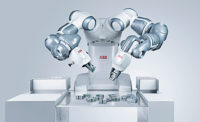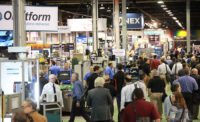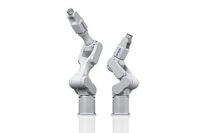The ASSEMBLY Show Preview

Richard Morris, vice president of assembly and logistics for BMW Manufacturing Co., will present the keynote address at the third annual ASSEMBLY Show. Photo courtesy BMW

BMW’s assembly plant in Spartanburg, SC, produced a record 364,000 vehicles in 2014. Some 70 percent of them were exported to 140 markets worldwide. Photo courtesy BMW

At press time, more than 1,500 manufacturing and design professionals had registered to attend The ASSEMBLY Show.

The conference program at The ASSEMBLY Show includes 29 hours of educational sessions covering topics ranging from power tools to vibratory feeders.

Engineers attending The ASSEMBLY Show can expect to see cutting-edge technologies, like these SmartGlasses from eFlex Systems. Photo courtesy eFlex Systems

Some 229 suppliers will display the latest technology at The ASSEMBLY Show.






BMW’s global production network consists of 30 factories in 14 countries. By the end of next year, the largest of those facilities will not be in Europe or Asia. It will be the automaker’s factory in Spartanburg, SC.
The factory is BMW’s only U.S. assembly plant. It is the company’s sole production site for the X3, X4, X5 and X6 crossover SUVs. In March, the company celebrated the 3 millionth vehicle to roll off the Spartanburg line since the plant began making cars in 1994.
The plant produced a record 364,000 vehicles in 2014. More than 80 percent of those vehicles were made to order, and some 70 percent of them were exported from South Carolina to 140 markets worldwide. In fact, the plant was the nation’s top automotive exporter in 2014. Citing data from the U.S. Department of Commerce, BMW said the plant’s exports totaled $9.2 billion last year, a 13 percent increase compared with its 2013 value.
The factory’s workflow will increase over the next few years as the German automaker executes a $1 billion plan to ramp up production to 450,000 vehicles per year, introduce a new vehicle—the X7—to its model lineup, and add approximately 800 new jobs.
Among other projects, the investment includes a 527,000-square-foot body shop that will house more than 650 robots. A 1,800-foot conveyor will transfer welded bodies from the body shop to the main building for finishing, painting and assembly.
When the expansion is completed in 2017, the plant will be BMW’s largest production facility in the world, employing some 8,800 people. Since 1992, BMW has invested nearly $7 billion in the plant.
“The expansion is a response to the continuing trend towards SUVs,” says Harald Kruger, chairman and CEO of BMW. “The X lineup accounts for almost one in three BMWs sold.”
The facility did not achieve such growth by remaining static. It has been a leader in implementing new assembly technologies. Collaborative robots help workers perform final door assembly. Material handling equipment powered by hydrogen fuel cells shuttle parts and supplies throughout the plant. The facility is even running a pilot project to determine whether the Google Glass wearable computer could improve workflow in quality assurance.
The facility has also been a leader in sustainable manufacturing. In 1998, the factory was one of the first automotive manufacturers to earn ISO 14001 certification for meeting or exceeding international environmental standards. From 2006 to 2014, per vehicle shipped, BMW’s South Carolina plant has decreased:
Water consumption by 59.3 percent.
Energy consumption by 61.6 percent.
VOC emissions by 45.3 percent.
Waste disposed of in a landfill by 89.4 percent.
Industrial wastewater by 55.1 percent.
You can learn more about this innovative assembly plant when Richard Morris, vice president of assembly and logistics for BMW Manufacturing Co., presents the keynote address at the third annual ASSEMBLY Show on Wednesday, Oct. 28, at 9 a.m. The show will be held Oct. 27-29 at the Donald E. Stephens Convention Center in Rosemont, IL, adjacent to Chicago O’Hare International Airport.
Sponsored by Promess Inc., the keynote address will focus on how to develop and sustain a culture of continuous improvement.
Morris began his career with BMW Manufacturing in 1993 following almost 10 years in quality engineering positions with various U.S. automotive manufacturers. Since then, he has held numerous positions with BMW, including a two-year assignment in Germany, where he served as the project leader for the next-generation X5 sports activity vehicle launched in 2006. Most recently, Morris served as assembly manager. He has a bachelor’s degree in mechanical engineering from General Motors Institute and a master’s degree in business administration from Clemson University.
Exhibits and Education
At press time, more than 1,500 manufacturing and design professionals had registered to attend the show. Registrants represent automotive manufacturers, like Cummins Allison Corp., Delphi Automotive, and Fiat Chrysler Automobiles; aerospace manufacturers, such as Curtiss Wright, Rolls-Royce and Woodward Inc.; appliance manufacturers, such as Insinkerator, Wahl Clipper Corp. and Whirlpool Corp.; machinery manufacturers, including Caterpillar, CNH and Deere; electrical manufacturers, such as Bodine Electric, Eaton and Juno Lighting Group; and medical device manufacturers, like Abbott, Baxter and Hu-Friedy Manufacturing.
Some 229 suppliers will be displaying the latest assembly technology at the show. Exhibitors include systems integrators, such as ATC Automation and Arthur G. Russell; robot suppliers, such as EPSON and Kuka; adhesive suppliers, such as 3M and Hernon; tool suppliers, such as AIMCO and Kolver; and plastics assembly companies, such as Branson and Dukane.
Besides the keynote, the conference program includes 29 hours of educational sessions covering topics ranging from power tools to vibratory feeders to automatic guided vehicles.
For example, on Wednesday, Oct. 28,
Nuzha Yakoob, senior product manager for electromechanical, motion control and mechatronic products at Festo Corp., will present, “How You Can Leverage the Smart Factory Today.” With product life cycles getting shorter and shorter, manufacturers are demanding more flexibility from assembly and test equipment. In this presentation, engineers will learn how new motion control and sensor technologies are helping systems integrators create flexible, intelligent assembly systems.
In-Depth Workshops
The exhibits at the ASSEMBLY Show will officially open on Tuesday, Oct. 27, at 5 p.m. That afternoon, however, the show will host three comprehensive workshops addressing additive manufacturing, mixed-material assembly, and design for manufacture and assembly (DFMA). The workshops will be held from 2 to 5 p.m.
Additive manufacturing is moving out of the lab and onto the shop floor. A technology that was once reserved for quickly making prototypes is now being used to produce jigs, fixtures and even production-ready parts. In fact, in April, a metal sensor housing became the first 3D-printed part certified by the FAA to fly inside a commercial jet engine.
The additive manufacturing workshop will cut through the hype to teach the true capabilities of this intriguing technology. Engineers will learn about the latest processes for additive manufacturing and how they can be used to improve products and assembly operations.
Presentations in this workshop include:
“Produce Durable Parts, Tools, Patterns and Molds with Fewer Contraints,” Allen Kreemer, manufacturing applications manager, Stratasys Ltd.
“Advances in 3D Metal Printing,” Sandeep Rana, vice president of technical sales for direct metal printing, 3D Systems Inc.
“Electron Beam Additive Manufacturing,” John O’Hara, sales manager, Sciaky Inc.
“Design for the Freedom of Additive Manufacturing,” Jim Hassberger, president, solidThinking Inc.
Another workshop will address methods for mixed-material assembly. Auto parts, appliances, medical devices and many other products these days increasingly contain a mix of materials—steel, aluminum, plastics, composites, glass and ceramics. Mixed-material designs might be implemented to reduce weight, cut costs, increase strength or simply improve aesthetics. While that’s all well and good, manufacturing engineers are discovering that many of their time-tested assembly methods are no longer practical or effective.
In this workshop, engineers will learn about new and innovative technologies for mixed-material assembly. Presentations include:
“Laser Joining of Dissimilar Materials,” Narasimhan Sreenivasan, applications group manager, Trumpf Inc.
“Shedding Light on the Plastic Staking Process,” Kelly Binnendyk, applications lab manager, Extol Inc.
“Adhesives for Mixed-Material Assembly,” Michael Pomykala, applications engineer, Henkel Corp.
“Fasteners for Mixed-Material Assemblies,” Bastian Hartmann, project manager, Bollhoff Inc.
Back by popular demand is the DFMA workshop. This workshop will show engineers how to analyze and reduce the cost of their designs. At least 85 percent of manufacturing costs are determined in the early stages of design. When engineers make informed design decisions during the concept stage, they can avoid costly corrections later on.
In this workshop, engineers will learn how to lower manufacturing costs through good design; how to consolidate features and reduce fastener counts; and how to design parts to facilitate automation.
Presentations include:
“DFMA as a Key Product Management Tool,” Chris Tsai, director of DFMA implementation services, Boothroyd Dewhurst Inc.
“Get Into the Flow With DFMA Product Simplification,” David Sweet, national sales manager, Boothroyd Dewhurst Inc.
“Design From the Inside Out: How Teardowns Can Improve Your Assembly,” James A. Rains, Jr., CVS, FSAVE, president, Advanced Value Group LLC.
“Design for Sustainability and Resilience,” Joseph Fiksel, executive director, Sustainable & Resilient Economy Program, The Ohio State University.
For a complete lineup of speakers and exhibitors at the ASSEMBLY Show, visit www.theassemblyshow.com.
Automated Assembly Systems Pel Discussionand Parts Review
One of the great traditions of The Assembly Show is that engineers often bring sample parts or assemblies with them to review directly with exhibitors.
In the spirit of that tradition, we invite attendees to bring sample parts to a special panel discussion on Thursday, Oct. 29, from 10:30 to 11:10 a.m. with the aim of getting informal advice about automated assembly from the country’s top systems integrators (and perhaps even their peers). What might an assembly system for the parts look like? How might the parts be better designed for automated assembly? What might be potential trouble spots?
Whether you’re currently running a multistation automated assembly system or are thinking about automating for the first time, you won’t want to miss this golden opportunity to learn from experienced experts in automation.
The panel will be moderated by John Sprovieri, editor in chief of ASSEMBLY magazine. Panelists will represent several systems integrators, including PrimeTest Automation Inc. and Arthur G. Russell Co. Inc.
Looking for a reprint of this article?
From high-res PDFs to custom plaques, order your copy today!












